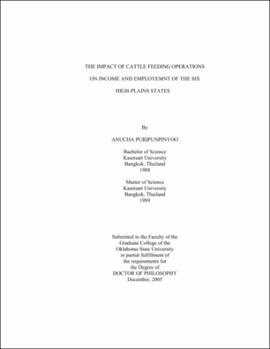| dc.contributor.advisor | Stoecker, Arthur | |
| dc.contributor.author | Puripunpinyoo, Anucha | |
| dc.date.accessioned | 2013-11-26T08:22:05Z | |
| dc.date.available | 2013-11-26T08:22:05Z | |
| dc.date.issued | 2005-12 | |
| dc.identifier.uri | https://hdl.handle.net/11244/6537 | |
| dc.description.abstract | Scope and Method of Study: The study area contained 222 counties from the Six High-Plains States of Colorado, Kansas, Nebraska, New Mexico, Oklahoma and Texas. County level two digit SIC data were collected for the period from 1977 to 2000. The RAS method was used to estimate missing or withheld data. The ten two digit SIC sectors were agricultural services, manufacturing, wholesale trade, retail trade, Finance, Insurance and Real Estate (FIRE), services, construction, mining, transportation and public utilities, and government. Time-series cross-section geometric distributed lag models were used to estimate the employment multipliers. The spatial relationship between counties was also considered. | |
| dc.description.abstract | Findings and Conclusions: The main variables affecting agricultural service employment were agricultural cash receipts and personal income. Manufacturing employment was shown to be affected by crop income, fed cattle slaughter, the real value of Gross State Product (GSP) in the county and changes in manufacturing employment in the rest of the United States. Employment in the wholesale trade sector was significantly affected by the real value added by the basic and non-basic sectors in the county and by retail trade employment. Retail trade employment in small, medium, and large size counties affected by personal income. It was found the concentration of retail employment in medium and large size counties could be explained the expenditure of a proportion of income earned in smaller counties in the closest medium and larger counties. Similarly a portion of income earned in medium population counties was spent in the closest large county or SMSA. Employment in the Finance, Insurance and Real Estate sectors was best explained by real value added in the trade and non-trade sectors and personal income in the same county. Services employment was also explained by the real value-added in the trade and non-trade sectors and the population of the county. Construction employment was explained by the real value added and the personal income earned each county. Mining employment was explained by price of crude oil and the real value added by the basic and non-basic sectors of the county. Employment in the transportation and public utilities sectors of a county was also explained by the real value added in the county and by the population of the county. Likewise government employment was explained by the real value added and by the population of each county. | |
| dc.format | application/pdf | |
| dc.language | en_US | |
| dc.rights | Copyright is held by the author who has granted the Oklahoma State University Library the non-exclusive right to share this material in its institutional repository. Contact Digital Library Services at lib-dls@okstate.edu or 405-744-9161 for the permission policy on the use, reproduction or distribution of this material. | |
| dc.title | Impact of cattle feeding operations on income and employment of the six High-Plains states | |
| dc.contributor.committeeMember | Sanders, Larry D. | |
| dc.contributor.committeeMember | Hattey, Jeffory A. | |
| dc.contributor.committeeMember | Schatzer, R. Joe | |
| osu.filename | Puripunpinyoo_okstate_0664D_1580.pdf | |
| osu.accesstype | Open Access | |
| dc.type.genre | Dissertation | |
| dc.type.material | Text | |
| thesis.degree.discipline | Agricultural Economics | |
| thesis.degree.grantor | Oklahoma State University | |
